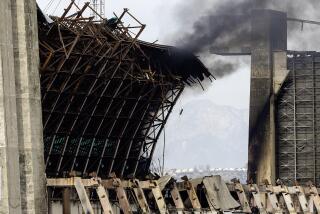Plan to Rid Fallbrook Ammo Dump of Surplus Napalm Fails
- Share via
Once again, the Navy’s efforts to rid itself of 2.7 million gallons of napalm left over from the Vietnam War, and stored in a field in Fallbrook, have fallen through.
The U.S. Department of Defense this month canceled an Arizona salvage firm’s contract to break down the flammable jelly into its constituent parts because the firm missed repeated deadlines to finish building a special contraption to do the job, officials said Monday.
“Well, it’s disappointing because we don’t like to have it sitting around there,” said Phil Stewart, a spokesman for the Defense Reutilization and Marketing Service in Battle Creek, Mich., which canceled the contract. “We were hoping it would be long gone by now.”
The napalm--a sticky mix of gasoline, benzene and polystyrene prepared for use against people in wartime--has been stored in 33,800 aluminum canisters since 1972 at the Fallbrook Naval Weapons Station.
In November, 1983, the Navy signed a contract with Bud’s Oil Service of Phoenix under which Bud’s was to pay the Navy $380,000 for the right to break down the napalm into its component chemicals and cart them away for resale.
But Bud’s failed to construct the special system that it and the Navy believed could break down the napalm, Stewart said. Stewart and Billy Kinder, a Navy spokesman in San Diego, said Bud’s had laid down a concrete pad and begun to put the equipment together but had run into financial problems.
“As I understand it, he developed in theory a process that ought to work if he can get the equipment together to do it,” Stewart said. “ . . . But unfortunately we didn’t get to the point where we could actually see a demonstration of anything being done.”
The Defense Department has not decided whether it will refund Bud’s $78,000 deposit, Stewart and Kinder said. They said the firm could conceivably get a new contract if it rebid, since it has already invested a significant amount of time and money and appears to be one of few firms capable of completing the process.
Steven Hogg, the president of Bud’s, could not be reached for comment.
The Navy has been attempting to get rid of the leftover napalm since 1978, when it declared the stockpile excess and said it would not be needed. It had sought repeatedly, but with little luck, to sell it to private recycling firms.
Then in January, 1982, two trucking firms from Riverside and Barstow agreed to pay $182,000 for the stuff. A year later they backed out, saying county environmental restrictions made the job too costly.
Hogg, who had planned to sell a mix of gasoline and benzene as motor fuel and market the polystyrene separately, had said he expected to make at least twice what he had bid.
Officials insisted that the canisters, which have leaked, pose no significant threat to the environment or public health. Stewart said they are monitored regularly.
More to Read
Inside the business of entertainment
The Wide Shot brings you news, analysis and insights on everything from streaming wars to production — and what it all means for the future.
You may occasionally receive promotional content from the Los Angeles Times.










